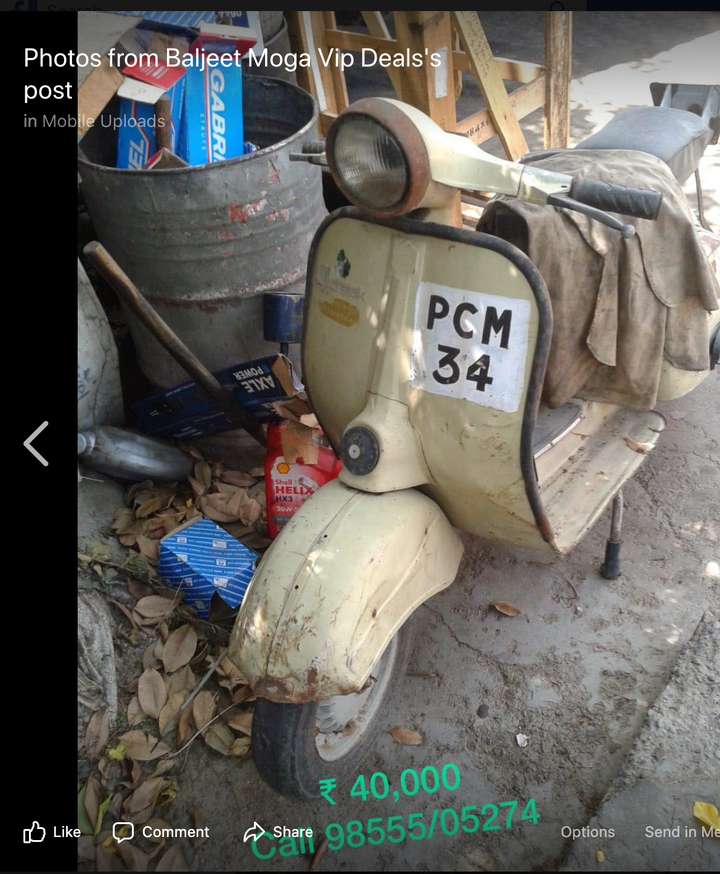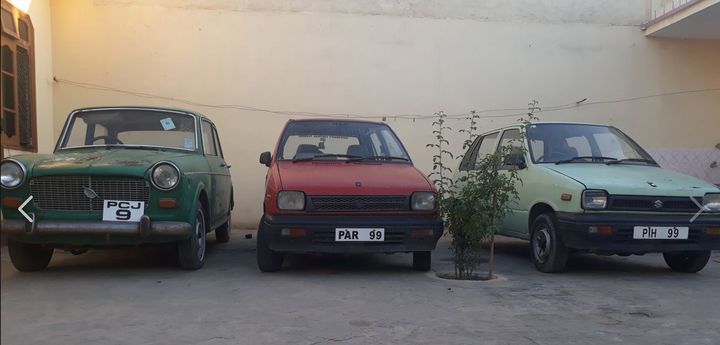CHANDIGARH — When the Motor Vehicles Act of 1988 standardized a common template for automobiles registration numbers across the country, most states complied with the new directive without a murmur.
In some states including Punjab, the influential and politically connected few continue to find novel – and illegal — ways to flout the law and flaunt old-school license plates that pre-date the 1988 law on fancy new blinged out cars.
A demand for vanity registration numbers that begin with three-letter sequences such as PCS, PEG, PIA or PAL in Punjab HuffPost India has learnt, has spawned a thriving black market involving officers in the Registration Transport Authority (RTA), scrap-dealers, touts and car salesmen: Old vehicles destined for the junkyard are bought and sold for hundreds of thousands of rupees solely with the aim of transferring the scrapped vehicle’s license plate to new vehicles.
Adding more chaos, this network of agents and officials has even found a way to ensure these old-numbers, which are in violation of the law, are uploaded onto Vahan, India’s centralized motor vehicles registry.
Petitions have been filed in the Punjab and Haryana High Court to allow these old vehicle registration numbers — some of which pre-date Independence — to continue. The Punjab government has played its part, by turning a blind eye to this obvious violation and pretending that the issue falls into a grey area of the law.
When Punjab Advocate General Atul Nanda submitted a report warning the state government that these so-called “fancy numbers” are in violation of the law, HuffPost India learned, the state government asked him to review his report and also approached the Ministry of Road and Surface transport to alter provisions of the motor vehicles act to ensure Punjab’s VIPs could keep their status symbols alive.
Priyank Bharti, Joint Secretary, Ministry of Road Transport and Highways told HuffPost India that the ministry is yet to formulate an opinion on this “grey area” of the motor vehicles act.
“So far, Haryana had approached us to convert the old numbers as per the new format and we supported their decision. While some states have converted the old numbers as per the new registration mark format, many states are in the process,” said Bharti.
Advocate General Nanda declined to comment.
Some legal experts say the law is clear.
“There is no grey area in the motor vehicle act but gaps have been intentionally created by the states to allow the mighty and the powerful to retain the VIP status,” said Ranjan Lakhanpal, a senior advocate at the Punjab and Haryana High Court. “You cannot sell a vintage number and can only own it. This demands a detailed probe.”
HOW IT BEGAN

The state transport department has recently sought a legal analysis on the validity of the use of the old number series allotted under the Motor Vehicle Act, 1939.
The report (reviewed by HuffPost India) mentioned how the same registration marks were assigned to different vehicles. The report also raised concern over the existence of a parallel illegal system of retaining old numbers issued under MV Act, 1939.
The officials have also raised concerns over the manipulation of the official records of the old vehicle number series and how the majority of them were purposely lost.
HuffPost India interviewed agents, and accessed registration documents, to find out how the scam works. When the Motor Vehicles Act was passed in 1988, all states were assigned a two-letter abbreviation (For example DL in case of Delhi), followed by an 8 digit alphanumeric code.
Hence all new license plate numbers should be a minimum of 10 digits which represents a state followed by the sequential of the district and the respective registration authority and lastly a four-digit unique number assigned to the vehicle.
A Ludhiana-based agent said the scam began in 2012 when a group of unscrupulous transport officials conducted a door to door survey in several districts in Punjab to identify people who still owned vehicles with the old-style license plates.
The Motor Vehicles Act of 1988 had offered a 15-year window for those with old-dated license plate numbers to apply for fresh plates, but many hadn’t done so as the actual owners had died years ago. The transport officers, the agent said, told their next of kins to either surrender their license plate numbers or pay heavy penalties.
The holders of these old-school license plate numbers did not know that these old-dated plates commanded very high prices in the black market.
“Concerned over the heavy penalty, the families were the actual owner had either died or migrated to other countries, surrendered the registration mark by signing an affidavit after which each number was later sold by the mafia worth lakhs,” said the agent.

Vigilance department is carrying out multiple investigations pertaining to one of the oldest and the biggest corruption scandal simultaneously at Bathinda, Patiala and Jalandhar by the vigilance departments.
Senior officials requesting anonymity have informed HuffPost India that the agents have managed to transfer the old numbers on their names by fabricating the old DDRs and fake affidavits.
“To retain a vintage number, one needs to be a registered owner of the vehicle and should be in possession of the vehicle. Secondly, he should get the fitness test done by the MV inspector as per the period specified in the MV act. Our investigations have shown that over 90 percent of the first owners have died but the numbers purchased by them decades ago are still in use,” said a senior Vigilance officer heading the investigation in one of the districts.
He further informed that to transfer a ‘retained’ vintage number, one needs to first buy a new registration mark for the new vehicle and later get it swapped with the old vehicle. The Vigilance department is investigating cases as to how the vintage numbers whose owners have died years ago are getting backlogged into the Vahan portal in the last few months.
“This also poses a serious security threat in a border state like Punjab. Since the majority of these numbers are owned by top political leaders, the cops deployed at the check posts do not gather the courage to stop them. They do not even check whether the number plate is genuine or fake hence giving a free way to people involved in illicit trade like drugs,” said another official.
“Our investigations have shown that over 90 percent of the first owners have died but the numbers purchased by them decades ago are still in use.”
- A District Vigilance Officer investigating the case
Punjab’s so-called “transport mafia” took to buying scrapped vehicles for rock-bottom prices, and then sold off their vintage numbers the black market. Some numbers, HuffPost India learned, were sold for as much as Rs 20,00,000.
HuffPost India also spoke to some car owners who had bought these numbers. In one case study, a Jalandhar-based car dealer bought a 1978 Ambassador with a vintage registration mark for Rs 5,00,000 in 2013 and in December 2019 transferred this number to his brand new Toyota Land Cruiser.
While finding old vehicles with obsolete number plates is relatively easy, transferring these license plates to new cars and uploading to the Vahan database requires special permission from the Regional Transport Authority (RTA) and final approval from the State Transport Commissioner’s office. The process is called “back-logging” – whereby numbers that are not entered into the online Vahan repository can be registered once they are cleared by the relevant officials.
Yet, if local press reports are to be believed, state transport officials themselves are under tremendous pressure from state politicians. Last month, Dainik Bhaskar reported on the unusual case of Parikshit Goyal, a man who bought a 15-year-old scooter with the license plate number PBQ 0001 and tried to get this number transferred onto his Toyota Innova only for the RTA to tell him he had to surrender the number because a senior Punjab politician had taken a fancy to this particular registration number.
IS IT LEGAL?
Can the old numbers issued prior to 1989 be used today? As per the legal analysis done by the state transport department, they cannot be sold or transferred to other vehicles purchased after 1989. Some of the points mentioned in the legal analysis are listed below:-
As per chapter IV of the registration of the Motor Vehicle Act, after the enactment of the new act in 1988, the vehicles cannot be registered under the provisions of the MV act, 1939.
While clause (B) of section 217 of the MV act, 1988 provides for the continuity of the certificate of registration issued under the MV Act, 1939, there is no such provision where the distinguishing numbers assigned under the MV act, 1939 can be assigned to vehicles registered under the new act.
Also, section 41 (6) of the MV Act, 1988 states that the registration marks should include the letters and figures as allotted by the central government from time to time. Since Punjab was allotted PB as the first two letters, the registration mark without these two letters cannot be assigned to any vehicle after 1989.
In 2010, the Ministry of Road Transport and Highways vide its letter no. RT-11036.21/2009-MVL allowed the vehicle owners to retain the old registration marks on their new vehicles. However, where old vehicles were not scrapped, the state governments were asked to assign new registration marks to the old vehicles.
“Following this, an amendment was made in section 42 A of the Punjab Motor Vehicle Rules, 1989 where the RTAs were allowed to assign a registration mark to the owner of a motor vehicle of his choice as specified in the sixth schedule of the Motor vehicle rules. Since the sixth schedule of the Punjab MV rules provides the retainment of only the last four numbers of the registration mark, the old numbers cannot be retained under this garb,” said an RTA on condition of anonymity.
The legal analysis also made it clear that no such letter issued by the central government can override any provisions of the MV act and hence only those registration marks assigned as per the notification issued under section 41 of the MV act will remain valid.
For now, the black market in old license plate numbers continues unabated over the last decade.
Punjab State Transport Commissioner Amarpal Singh and State Transport Secretary K Shiva Prasad remained unavailable for comment.